An RV, or recreational vehicle, is a type of vehicle that is designed for travel and camping. It is self-contained and includes living quarters, such as a kitchen, bathroom, and sleeping area, that can be used for both short and long-term trips.
There are essentially 2 primary categories of RVs: Motorized and Towable.
RVs come in a variety of styles that are generally classified into “classes” based on their size, features, and intended use. These class labels can get pretty confusing and technically there are even more classes than we listed below; for example, a hybrid expandable trailer with a tent pop-out like a pop-up camper, or a Class B Plus model that falls in between a van and a Class C.
We know… it can all sound confusing! In our marketplaces and throughout our website, we organize all the incredible remodeled RVs we see most often into these primary RV class categories.
Rule #1 when shopping for an RV… have an open mind!
Especially if you’re a first-time RV owner, you may be surprised by all the strange things you’ll learn about the RV industry.
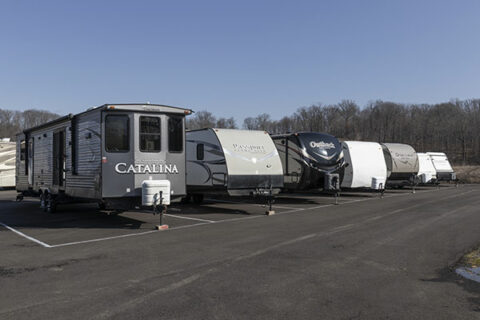
When we first started walking dealerships and used RV lots when shopping for our first RV, we dismissed many of the suggestions from the salesmen. “They don’t really understand what we want,” we said to ourselves.
After buying, remodeling and selling a couple RVs over the past few years, we now understand that we didn’t know what we really wanted. Until we spent significant time traveling and living in different RVs, we didn’t really have a good list of what we actually needed vs. what we thought we needed. And our needs have changed over the years as we added more kids, kids grew up, and our activities changed requiring different type of camping and and outdoor gear.
We always suggest that first-time RVers approach the shopping stage with an open mind. And even after you think you’ve narrowed down your desired RV size and floorplan, we suggest you rent one (check out our rental marketplace, RVezy, RVShare or Outdoorsy) and take it for a short camping trip. It’s one thing to walk around a stationery RV at the dealership, but you might change your mind after spending a couple nights inside that same type of RV.
You may end up buying something completely different than what you originally planned on buying. Or you may end up changing to a different class of RV down the road. Kids come along, they get bigger and need more space, maybe you add a dog to the mix, life changes and so will your expectations with your future RV. Take your time and do some research before you narrow your options too quickly. RV shopping should be fun!
Pros & Cons of Each Class of RV
Every person and family’s interests and needs are unique, especially when it comes to shopping for an RV.
The good news… over 600,000 new RVs have sold each of the past couple years. That means there are a lot of floorplans, styles, and sizes to choose from within your budget.
The bad news… there really aren’t a lot of things you can change from one floorplan to the next. Slide outs and rear patio decks can help extend the living space, but an RV is still constrained by 4 walls traveling down the road on wheels.
We’ve compiled a good list of reasons why you may or may not like each particular class or type of RV below…
Fifth Wheel
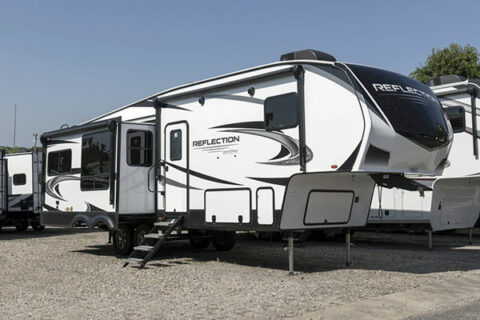
As they say, “this isn’t your grandparents’ RV!” 5th wheels (or 5ers as some people call them) are the real deal nowadays. Spacious and comfortable with just about all the amenities you could ever want out on the road.
A fifth wheel trailer is a type of recreational vehicle that is designed to be towed by a pickup truck or other large vehicle equipped with a fifth wheel hitch. The hitch connection consists of a horseshoe-shaped coupling device that attaches to the bed of a pickup truck, and a vertical plate that attaches to the bottom of the trailer. The fifth wheel hitch allows for more stability and control while towing, as well as greater weight capacity compared to other types of trailer hitches.
5th wheel trailers typically have a raised forward section that sits over the bed of the truck, allowing for more living space and storage than a traditional travel trailer.
They come in a wide range of sizes and styles, from small, lightweight models that can be towed by a half-ton truck, to large, luxury models with multiple slide-outs and high-end amenities. Typically, fifth wheel trailers are larger than traditional travel trailers and come with more amenities that make it feel more like a “home on wheels” rather than a camper. Many manufacturers are now even offering residential appliances as standard options inside their fifth wheel floorplans.
General Specifications
Size: 25 to 44 feet
Weight: 7,000 to 20,000 lbs
Price: $35,000 to $120,000+
Pros
More living space: Fifth wheel trailers are typically larger than travel trailers and have more room for living space. Many trailers come with slide-outs that expand the living space and the roof is often taller so the space feels more spacious inside.
Stable towing: The hitch on a fifth wheel trailer is located in the bed of the tow vehicle (generally a pickup truck), which provides a more stable towing experience compared to a “bumper pull” trailer.
More storge space: Especially in the larger fifth wheel trailers, you’ll find a multitude of storage cabinets inside and outside to bring along all your camping and outdoors gear.
Luxury amenities: Many fifth wheel trailers come with high-end amenities such as large kitchens, bedrooms, bathrooms and entertainment centers. Many manufacturers now even install full-size residential appliances.
Vehicle and RV are separate: You can park the trailer then explore the area in a vehicle rather than driving the RV around with you as your vehicle. Obviously larger Class A motorhomes can tow a vehicle behind, but then you have 2 engines (motorhome and vehicle) you have to maintain and potentially repair.
Higher clearance: The underbelly, axles and jack stands are often higher from the ground on a fifth wheel trailer. The hitch on a fifth wheel trailer is also located higher up on the truck bed, which allows for better clearance when driving through rough terrain. We’ve seen many fifth wheels boondocking in very remote areas that would be nearly impossible for other types of RVs to access.
Higher quality construction: Many fifth wheel trailers are built with higher quality materials and finishes than traditional travel trailers, providing a more luxurious living experience.
Cons
Initial cost: Fifth wheel trailers are typically more expensive than travel trailers.
Towing vehicle: A fifth wheel trailer requires a specific type of tow vehicle—usually a pickup truck—which may be more expensive to purchase or rent. Not all pickup trucks come equipped with the necessary truck bed attachments for your fifth wheel hitch. And the larger the fifth wheel, the more powerful (and expensive) the truck you’ll need to tow that trailer.
Size: Fifth wheel trailers are often larger and may be difficult to maneuver in tight spaces.
Learning curve: Unless you’ve towed a fifth wheel or gooseneck trailer before, you will find that it’s a new experience learning to hookup, backup, park, turn and tow a fifth wheel trailer connected in the bed of your truck. Over time, many people find it easier to tow a fifth wheel compared to a “bumper pull” travel trailer, but it takes a little time to learn.
Setup: Setting up a fifth wheel trailer can be more difficult and time-consuming than a travel trailer.
No usable truck bed space: The fifth wheel hitch generally stays affixed to the truck bed. Most hitches take up a good amount of the usable space in your truck bed so you either have to remove a bulky, heavy hitch when you want to use the truck bed, or you just don’t have as much truck bed capacity with the hitch installed.
Heavy: Fifth wheels are often one of the heaviest types of trailers available. Especially if you opt for a toy hauler fifth wheel, you could be looking at a trailer topping 20,000lbs.
Of course, this is not a comprehensive list of all the pros & cons of fifth wheels, but you can see why they are a very popular choice for many families living and traveling full-time.
Class A Motorhome
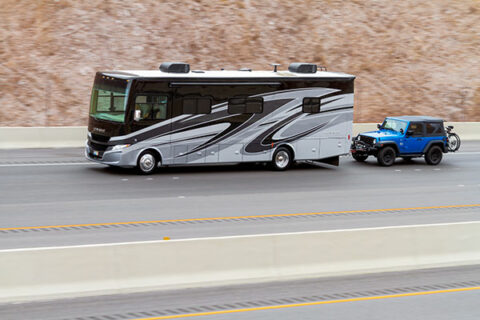
When someone not familiar with the RV industry hears that you are shopping for an RV, they most often associate a Class A motorhome as a “recreational vehicle” or RV.
In reality, every type of van, trailer and camper class listed in the guide on this page is also an RV, but there’s a reason Class A motorhomes are synonymous with the word RV. They’re the largest, fanciest, and most expensive RV class.
A Class A motorhome is a type of recreational vehicle that is built on a bus or truck chassis. They are the largest and most luxurious type of motorhome, and are typically equipped with many of the same amenities and features as a traditional “sticks and bricks” home, including a full kitchen, bathroom, sleeping quarters, and living area. Many models even include washer/dryers, dishwashers, and fireplaces.
Class A motorhomes are known for their spacious living area and large windows, which allow for plenty of natural light and great views while on the road. They usually have a lot of storage space and some models can even have slide-out sections that extended to provide more living space when parked.
They are sometimes powered by a gasoline engine but are often powered by a diesel engine (known as a “diesel pusher”) and are designed to be driven primarily on paved roads and not off-road, remote trails.
As Class A motorhomes are the top-of-the-line RVs on the road, expect to pay a premium for the luxuries you don’t find with other types of RVs. It’s also important to keep in mind that the purchase price is not the only cost associated with owning a Class A motorhome. Additional costs such as insurance, maintenance, repairs, fuel, and camping fees, should also be considered when determining the overall cost of ownership.
You get what you pay for with large motorhomes. They offer a level of luxury and convenience that can make them worth the investment for those who plan to spend a lot of time traveling in their RV, which is why they are often the go-to choice for retirees or “snowbirds” who want to travel in comfort.
General Specifications
Size: 26 to 45 feet
Weight: 13,000 to 30,000 lbs
Price: $100,000 to $350,000+
Pros
Large living space: With most models featuring multiple slide-outs to expand the interior even further, Class A motorhomes can comfortably accommodate large families or groups of friends.
Many high-end amenities: You’ll find amenities such as full kitchens, bathrooms, and bedrooms are common in most models. They also often include multiple TVs, sound systems, and other luxury features not seen in other types of RV classes.
Generator: Many models include a built-in generator, making it easy to boondock (camp without electrical hookup).
Plenty of storage: Most Class A motorhomes have “basement” storage compartments underneath the living space which can provide ample storage space for gear and supplies.
Cons
Commercial driver’s license: In some states you are required to have a commercial driver’s license (CDL) or other form of license or training to drive larger RVs. Check with your local department of motor vehicles (DMV) to see your local rules.
Challenging to maneuver: Class A motorhomes can be difficult to drive and maneuver, especially in tight spaces or on winding roads, due to their large size and weight.
Difficult to park: Larger and heavier than other types of RVs, you may find it difficult to find suitable parking and campsites.
Higher insurance costs: Class A motorhomes are the largest RVs on the road and as such are the most expensive to insure.
Poor gas mileage: Class A motorhomes can consume a significant amount of fuel, especially when fully loaded or driven at high speeds.
High initial cost: The size, comforts and amenities come with a higher cost of purchase and maintenance than other types of RVs.
Highways only: The large size and weight combined with low clearance make them generally unsuitable for off-road travel or rough terrains.
Storage limitations: Bigger rigs require a larger space for storage when not in use. You may not have a driveway or parking spot large enough to store it long-term so you may be seeking out RV storage facilities with a monthly rental fee.
Class B – Van
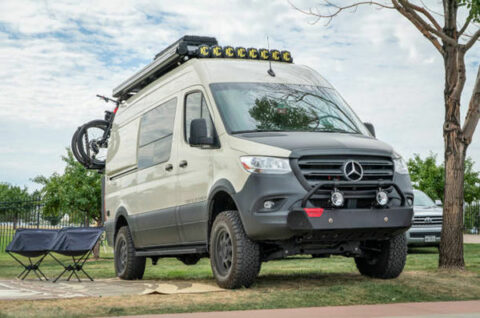
A Class B motorhome, also known as a campervan, looks like just a regular van with some tricked-out accessories, but they are technically a type of RV (literally a “recreational vehicle”).
This class of RV is built on a large van chassis with the most popular vans being Ford Transit, Mercedes Sprinter and Ram ProMaster.
Even though they are often cargo sized vans, they are still very compact and utilize multipurpose spaces and features that can transform depending on the intended use. They typically have a raised roof to provide more headroom and living space than a standard van.
Class B motorhomes are smaller and more compact than other types of RVs, such as Class A and Class C motorhomes, and are often used for shorter trips and for navigating through city streets and tight spaces, although many people are now using vans for extended travel of even full-time living.
In the everchanging and growing RV industry, there are now sizes that don’t fit squarely in the Class C category but they’re slightly larger than a normal campervan. So it’s not uncommon to find RVs listed as Class B Plus with the “plus” indicating that it’s typically larger than a Class B campervan but is probably narrower or smaller than a Class C camper.
They can typically sleep 2-4 people in a Class B van, and have basic amenities such as a kitchen, bathroom and sometimes a shower.
Campervans can be more budget-friendly than other types of travel accommodations, especially when traveling for an extended period of time. By having your own accommodation on wheels, you can save money on hotels and other accommodation costs. Additionally, if you choose to cook your own meals in the campervan, you can save money on food as well.
General Specifications
Size: 18 to 24 feet
Weight: 6,000 to 11,000 lbs
Price: $25,000 to $200,000+
Pros
Mobility: Campervans allow for the freedom to travel and explore new places without being tied to a specific location. This means that you can go wherever you want, whenever you want, without having to worry about finding a place to stay. This makes them ideal for road trips, or just exploring new areas on a whim. Setup and take-down at a camp site is often as easy as just closing the sliding door, putting on your seatbelt and driving away.
Cost-effective: Campervans can be more budget-friendly than other types of travel accommodations, especially when traveling for an extended period of time. Of course, like any purchase you could splurge and spend a lot more than the budget-friendly versions, but we’ve seen complete DIY renovations that look great and cost less than $5,000 for renovations.
Versatility: Campervans are generally thought of as a camping vehicles, but they can be used for a variety of activities including tailgaiting, roadtripping, or even just every day grocery drivers or “soccer mom” vans.
Comfort: Campervans typically come equipped with basic amenities such as a bed, kitchen, and bathroom, making them more comfortable than tent camping. Your definition of “comfort” may actually find the tight living quarters of a van restrictive, but it’s all relative to what type of camping or travel you’re looking for.
Fewer restrictions: Campervans are generally allowed in any campground or even national parks. Because of their compact height and length, you don’t generally have to worry about weight restrictions on bridges or roads or low bridge warnings where other RVs can’t travel.
Cons
Limited space: Campervans can feel cramped inside and storage space is extremely limited. This means that you will need to be mindful of what you bring with you and be prepared to get creative with storage solutions. Additionally, you may need to plan your travel itinerary to ensure that you have access to laundry or shower facilities depending on your van amenities.
Limited seat belts: Campervans are designed for individuals, couples or a small family with just 1-2 kids. You can occasionally find a campervan fitted with enough seatbelts to seat 3-4 kids, but those are rare. Not to mention seatbelts don’t necessarily mean you have sufficient space to comfortably sleep that many people. Although it’s not uncommon to see larger groups add a rooftop tent to sleep extra people.
Maintenance: Campervans require regular maintenance and repairs that a regular van or truck would require, which can be quite costly as you add on miles and put the vehicle under wear and tear as you explore remote areas. This means that you will need to budget for these expenses and be prepared for unexpected repairs. And you may need to research and find a reliable mechanic who has the specialized skills to work on your campervan.
Gas mileage: Campervans are much heavier than a typical minivan or SUV because they have added features like a kitchen, bed, and your camping gear. This can result in poor gas mileage.
Trendy costs: Because vans have been popularized by social media, many accessories have been created to fulfill campervan owner needs. That’s a good thing if you have a specific need in mind, but it can be tempting to add every modification or trendy accessory that comes out. The budget-conscious camper might find it a challenge to stick with the basics and avoid going over budget.
Class C Motorhome
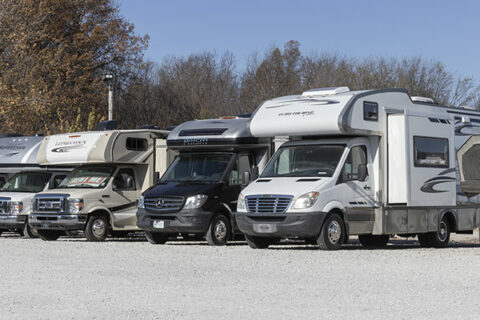
A Class C motorhome, also known as a mini motorhome or mini RV, is a type of recreational vehicle that is built on a truck or van chassis often with a cab-over section that extends over the driver’s seat. The cab-over section usually contains a bed or sleeping area, and the rest of the motorhome has amenities such as a kitchen, bathroom, and living area.
They are larger than Class B campervans, and can sleep six or more people. They typically have more space and more amenities than a campervan, but are not as big as a Class A motorhome.
Class A, B and C are often compared because of their similarities. They all have engines and a cab for driving so they are a good option for someone that wants to drive their RV rather than tow their RV. The biggest difference, as you’ll see in the pros & cons list below, is size. Class A is the biggest, Class C is in the middle, and Class B is the smallest. (We know, not the sequential naming you’d expect to see, but it’s just one of the many strange quirks about the RV industry.)
Some people prefer a Class C motorhome over the smaller class B campervans for long-term travel because they offer more space. And although they don’t have as much space as a larger Class A motorhome, they have better fuel economy. So they sit in the middle as a good compromise for comfortable, long-term RV travel.
General Specifications
Size: 21 to 41 feet
Weight: 12,000 to 20,000 lbs
Price: $75,000 to $200,000+
Pros
Size: Class C motorhomes are larger than Class B vans, but still smaller and more maneuverable than Class A motorhomes, making them a good option for those who want a bit more space and amenities without the hassle of driving a larger vehicle. You don’t need as much room to park in a parking lot so you often see these RVs at a grocery store or in national park parking lots. And you don’t need as much storage space for long-term storage as you would with the larger Class A motorhome.
Interior space: Class C motorhomes typically have more living space than a Class B motorhome or a campervan, making them more comfortable for longer trips or for families. They typically have a separate sleeping area and a kitchen/living area with more amenities than a campervan.
Amenities: Because they have more space inside, Class C motorhomes typically have more amenities and features than Class B vans, such as a larger kitchen, full bathroom, and dedicated sleeping areas. Appliances like refrigerator, stove, and air conditioning make them more comfortable and convenient for long trips.
Fuel economy: Class C motorhomes are typically built on a truck or van chassis, which tend to have better fuel economy than the larger Class A motorhomes.
Easy to drive: Class C motorhomes are also relatively easy to drive since they are built on a truck or van chassis, making them a popular choice among those who are new to RVing.
Cost: Class C motorhomes tend to be more affordable than Class A motorhomes, making them a more budget-friendly option for many buyers.
Cons
Size: While considered a “pro” in the list above, Class C motorhomes are smaller than Class A buses, but they are still larger than a campervan, which can make them difficult to park and maneuver in tight spaces. They are often too long for a typical parking spot. If you plan to drive your Class C motorhome through national parks or around busy areas, you may need to plan ahead for parking.
Gas mileage: Again, considered a “pro” in the list above when compared to larger Class A motorhomes, but if you use your Class C motorhome as your sole vehicle to drive around town when exploring an area, you won’t get the same gas mileage you might get from a Class A owner who towed a smaller vehicle that can be driven around town or even a fifth wheel owner who can unhitch his trailer and use his truck to drive around town.
Maintenance: Like any other motorized RV class with an engine, your Class C motorhome will require regular maintenance and repair. The more you drive it, the more wear and tear will add up. Additionally, many engines require specialized repairs or even visits to a truck shop instead of a regular car mechanic, which can be costly.
Pop-up Camper

A pop-up camper, also known as a folding camper or tent trailer, is a type of recreational vehicle that can be collapsed or “popped-up” for travel and then set up for camping. When collapsed for travel, it is a compact and lightweight trailer that can be pulled by a car or small SUV. Once at a campsite, the camper can be set up by raising the roof and extending the sides, creating a comfortable living space with beds, a small kitchen, and sometimes even a bathroom.
Pop-up campers are a great option for those who want the convenience of a camper but don’t want to invest in a larger, more expensive motorhome. They are also lightweight and easy to tow, making them perfect for those who want to explore remote and rugged locations. Pop-up campers are also relatively inexpensive compared to other types of RVs, making them a budget-friendly option for many buyers.
Pop-up campers can be divided into several subcategories based on their design and features.
- A-Frame pop-up camper: A-frame pop-up campers are lightweight and compact, featuring a tent-like design that can be easily set up and taken down. They typically have a small kitchen and sleeping area, and are often used for camping in more remote locations.
- Hard-sided pop-up camper: Hard-sided pop-up campers have a solid, permanent roof and walls, which can provide more protection from the elements than traditional canvas tent-like pop-up campers. They often have more amenities like a toilet, shower, and more sleeping area.
- High-wall pop-up camper: High-wall pop-up campers have higher walls when they are set up than traditional pop-up campers, which can provide more headroom and a feeling of more space. They often have more amenities and feature like air conditioning, heat, and more sleeping area.
- Toy hauler pop-up camper: Toy hauler pop-up campers are similar to traditional pop-up campers but with a cargo area at the front or back that can be used for storing things like motorcycles, ATVs, or bicycles.
General Specifications
Size: 8 to 16 feet
Weight: 1,000 to 3,000 lbs
Price: $9,000 to $20,000+
Pros
Portability: Pop-up campers are smaller and more lightweight than traditional RVs, making them more easily towed by smaller vehicles and can be stored in a garage or driveway when not in use.
Cost: Pop-up campers are generally less expensive than larger RVs such as a motorhome or travel trailer.
Basic amenities: Pop-up campers typically have basic amenities such as a bed, kitchen, and bathroom, making them more comfortable than tent camping.
Cons
Space: Pop-up campers have limited space and can feel cramped when the camper is set up.
Setup time: Unlike RVs with slide outs that can be setup with the push of a button, setting up and taking down a pop-up camper is a manual process that can be time-consuming and requires some physical effort.
Weather: Pop-up campers are not as well insulated as traditional RVs, so they may not be as comfortable in extreme weather conditions. The tent fabric doesn’t offer a lot of protection from wind and the elements.
Vulnerability: Pop-up campers are more vulnerable to damage from wind, rain, and other environmental factors, so they need to be properly secured and maintained.
You won’t find many people using a pop-up camper for extended or full-time travel due to the setup and take-down process as well as the lack of insulation and protection from the elements. But a pop-up camper is a great way to get the family out camping for the weekend without breaking the bank.
Travel Trailer
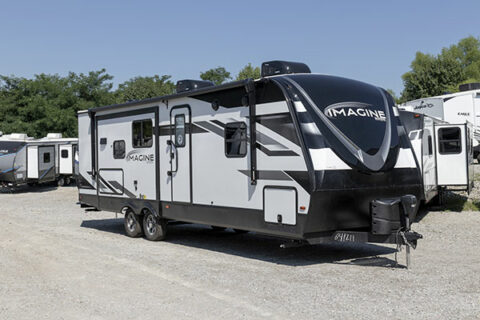
A travel trailer, also known as a “bumper pull” or even caravan in other parts of the world, is the most popular type of recreational vehicle.
The term “bumper pull” refers to the fact that the hitch attaches to the bumper, rather than to the frame of the vehicle.
They range in size from small, lightweight models that can be pulled by a small SUV or minivan (or even smaller as discussed below with micro campers), to large, luxury models that require a heavy-duty truck to tow.
Travel trailers typically have a living area, kitchen, bathroom, and sleeping area. They can be divided into two categories:
- Conventional travel trailer: These are the most common types of travel trailers, which are built on a frame and the walls are often made of aluminum or fiberglass. They come in a wide range of sizes and styles, and can be equipped with various amenities such as air conditioning, heating, and a full bathroom. They have everything you would expect in an RV with a kitchen, sleeping areas, and at least one bathroom.
- Toy hauler travel trailer: These types of travel trailers are the same as conventional travel trailers with the addition of a rear garage space with a door that folds down to allow toys such as ATVs, UTVs or motorbikes to be loaded into the garage. The rear door often doubles as a patio deck that many people find enjoyable on warm nights as a place to gather and enjoy the surroundings. Because these toy hauler trailers are designed to haul around toys, they are heavier and need to be towed by a stronger vehicle like a full-size pickup truck. Larger, heavier toys often require RV owners to move up from a travel trailer toy hauler attached to your truck’s bumper ball hitch to a fifth wheel toy hauler with a hitch attached to the truck bed for added stability and mobility.
Travel trailers are a popular choice among RVers because they offer a high degree of flexibility and mobility. They can be easily towed to different locations, set up at a campsite, and then hitched up and taken to the next location when the trip is over. They also tend to be more affordable than motorhomes and offer a wider range of sizes from compact and minimal to spacious trailers with multiple slide-outs that expand the living area.
General Specifications
Size: 12 to 35 feet
Weight: 1,000 to 9,000 lbs
Price: $10,000 to $75,000+
Pros
Cost effective: One of the main advantages of a travel trailer is that it is a cost-effective way to travel and see the country, especially if you already own a tow vehicle such as a truck that is capable of towing the trailer. You can save money on hotels and restaurants by cooking your own meals and having a place to sleep every night. This can be especially beneficial for families or groups of friends traveling together, as the cost per person can be much lower than other types of accommodation. And in comparison with other classes of RVs such as a motorhome or fifth wheel, you will often get similar features and total available living space for a better price. If RVs were appraised like a “sticks and bricks” home, you would find that a travel trailer is less $ per sq ft compared to other RV types like motorhomes.
Towing: Travel trailers can be towed by a variety of vehicles, including pickup trucks and SUVs, which can be an advantage if you don’t own a large motorhome or don’t want to invest in one.
Support network: Travel trailers are the oldest and most popular type of camper, so you will find a network of qualified and certified RV repair shops just about anywhere you choose to travel.
Flexibility: Travel trailers can be easily detached from the towing vehicle and parked in a campsite, allowing for more flexibility in where you can travel and stay.
Cons
Size: When you walk inside a travel trailer, you might feel like it’s the perfect compact size to tow around, but once you walk outside and realize the front trailer tongue adds a few more feet to the total length, you may find that a travel trailer is not as easy to drive and park as a car or even a large motorhome. This can make it difficult to navigate through small towns or crowded campgrounds, and it may require a lot of practice and patience.
Stability: A travel trailer can feel like a giant sail when driving on the highway with strong gusts of wind. You can (and should) utilize weight distribution sway bar systems to add some stability for towing longer trailers, but bumper pull trailers just aren’t going to feel as stable as a fifth wheel.
Long-term storage: Larger travel trailers require a significant amount of storage when not in use. Travel trailers are large and bulky, and they take up a lot of space in a garage or driveway. This can be an issue if you have limited storage space or are considering long-term storage options.
Toy Hauler
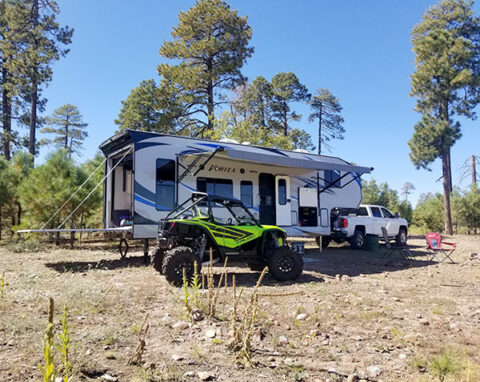
A toy hauler is a type of recreational vehicle that is specifically designed to transport and store “toys” such as ATVs, motorcycles, dirt bikes, and other recreational vehicles. They are versatile as you can use them for camping, tailgating, and even as a full-time residence.
Many families opt to travel in toy haulers even if they don’t utilize the garage for toys because the rear garage area can be converted into a large living and sleeping space with at least one queen bed and sometimes even more beds as you stack them in a bunk bed formation using motorized bed lift systems.
Toy haulers typically have a full living area, kitchen, bathroom, and sleeping area, and they usually come equipped with features such as air conditioning, heating, and a generator.
Toy haulers are available as a fifth wheel or a travel trailer. Both types have their pros and cons as discussed above on this page.
General Specifications
Size: 26 to 45 feet
Weight: 7,000 to 20,000 lbs
Price: $40,000 to $120,000+
Pros
Storage: Nothing compares to the space a toy hauler provides to store and transport vehicles such as ATVs, dirt bikes, or motorcycles or even just your camping gear if you don’t have toys.
Versatile living space: The separate garage area is about as flexible a space as you’ll find in an RV. Use it as a garage for your toys or gear or convert it into a living and sleeping space.
Holding tanks: Toy haulers often have larger holding tanks for water, grey water, and black water, allowing for longer trips without needing to stop and empty them.
Fuel station: Many toy haulers come with a built-in fuel station for fueling toys or simply as a backup fuel option for your tow vehicle which can come in handy when traveling and camping in remote areas.
Rear deck: The rear ramp door is convenient for loading the garage space with toys or gear, and it’s also a fan favorite as it doubles as a patio space to chill and relax at your camp site. And on hot days it can be nice to open that rear deck and allow more air flow to cool down the inside of your RV.
Cons
Heavy: Whether you have a fifth wheel or travel trailer, a toy hauler model is designed to carry toys so the frame is generally heavy-duty. That means even unloaded (your “dry weight”) you start with a heavier RV with a toy hauler. That likely requires a stronger, more capable truck to tow the toy hauler.
Less fuel efficient: Toy haulers are heavy to start with as mentioned above, and once you start loading toys and gear into the garage space, you’re hauling a heavy rig that lowers your fuel efficiency.
Size: It might be nice to have the rear patio deck or slide outs to expand your living area and improve your comfort while camping, but those expansions increase the overall footprint needed for parking and camping and could restrict the spaces you fit in.
Skoolie Bus
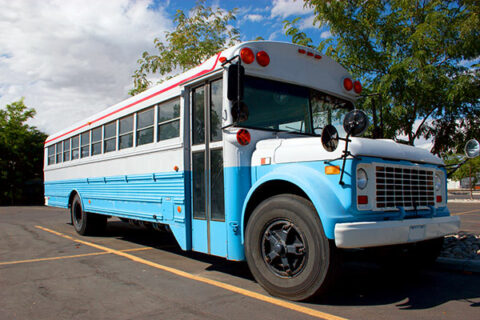
A Skoolie is a nickname for a school bus that has been converted into a recreational vehicle or a mobile home.
Skoolies are usually retired school buses that have been gutted, renovated and transformed into livable spaces. They can be outfitted with all the amenities of a traditional RV, such as a kitchen, bathroom, living area, and sleeping quarters.
Skoolies are becoming increasingly popular among people who are looking for an affordable and unique alternative to traditional RVs.
They have several advantages, such as a large amount of interior space, high ceilings, and large windows. They also have a durable, heavy-duty construction, which makes them well-suited for off-grid living and travel to remote locations. Additionally, they have a unique aesthetic that sets them apart from traditional RVs, making them a popular choice among people who want to stand out from the crowd.
However, converting a school bus into a Skoolie can be a significant undertaking, requiring both time and money. You can find old school buses for as little as $10,000 but it could then take $30,000-$50,000 to make it livable.
Renovation typically requires some level of DIY skills and knowledge of electrical, plumbing, and carpentry. It also requires some maintenance and modifications for safety and regulations. But for those who are willing to put in the work, a Skoolie can be a cost-effective and enjoyable way to travel and live.
General Specifications
Size: 20 to 45 feet
Weight: 15,000 to 35,000 lbs
Price: $10,000 to $50,000+
Pros
Low initial cost: A skoolie can be relatively inexpensive to purchase, as used school buses can often be found at a lower cost than other types of RVs. At that point, the cost of renovations is then up to you to determine.
Unique: Skoolies offer a unique and creative living space, as you can customize the interior to your liking. That means each skoolie is truly one-of-a-kind.
Durable: School buses are built to withstand heavy use and long trips and generally stay in service for many years, making them a durable option for full-time living or long-term travel when converted as a Skoolie.
Cons
Renovation costs: A skoolie starts as a school bus that needs to be stripped down and renovated before it can be a livable space. It can be difficult and expensive to renovated, and may require significant work and skill to make them comfortable and functional.
Uncomfortable driving: Just look up a video of drivers going down the road in a skoolie and you’ll often notice considerable bouncing in the driver seat. School buses are designed as a transport vehicle and not necessarily for comfort, so drivers may find them uncomfortable to drive long distances.
Low fuel economy: New school buses have seen improvements in fuel efficiency, but as most Skoolies are re-purposed old school buses that were not fuel efficient (one of the reasons they may have been retired from school service and available to purchase), it’s not uncommon to expect just 6-10 MPG range.
Compact living: While it might seem like living space is aplenty in a school bus 40 feet long, it’s worth noting that unlike many trailers or other RV types, Skoolies don’t have slide-outs that can be used to expand living space. So walking into a Skoolie might feel like a long, narrow hallway for some people uncomfortable in tight spaces.
Size: There’s no getting around it… unless you’re renovating a short bus, school buses are long, heavy vehicles that can be difficult to maneuver and park without a lot of practice.
Truck Camper
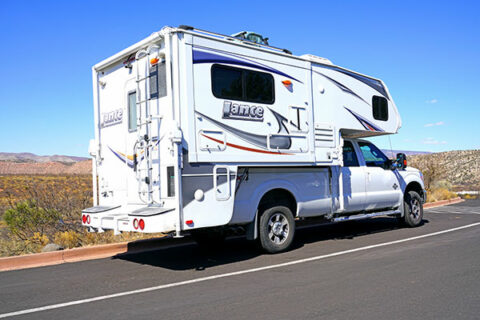
A truck camper is a type of recreational vehicle that is designed to be mounted on the bed of a pickup truck. It is a self-contained unit that includes a living area, kitchen, bathroom, and sleeping quarters.
Truck campers are typically smaller and more compact than other types of RVs such as travel trailers or motorhomes, and can be easily removed from the truck for use as a stand-alone camping unit.
Truck campers are popular among those who want to combine the convenience and mobility of a truck with the comforts and amenities of an RV. They can be used for a variety of activities, such as camping, hunting, fishing, and off-roading. They are also a good option for those who want to travel to remote locations, as the camper can be easily removed from the truck and set up at a campsite.
Truck campers come in different sizes and styles, from small, lightweight models that can be mounted on a compact truck, to larger, luxury models that require a heavy-duty truck to support. They can be equipped with various amenities such as air conditioning, heating, and a full bathroom.
General Specifications
Size: 10 to 20 feet
Weight: 1,000 to 4,000 lbs
Price: $8,000 to $40,000+
Pros
Mobility: Truck campers offer a high level of mobility and the ability to navigate off-road or difficult terrain. Rather than being limited by the clearance of the RV, you’re only limited by your truck.
Quick learning curve: Unlike a trailer or fifth wheel that you have to attach to the rear of your truck, a truck camper mounts to your truck bed without adding a lot of extra length to the truck you are familiar with driving.
Long-term storage: Truck campers can be stored and parked in smaller spaces than other types of RVs.
Separate vehicle: If you already own a capable pickup truck, a truck camper could be a great option to get away for the weekend. And once you get to your camp site, you can unload the camper and go explore town with your truck.
Cons
Uncomfortable: If you’re uncomfortable in small spaces, you will likely feel uncomfortable in a truck camper. While some truck camper models nowadays have slide-outs to expand the space, most truck campers are only as big inside as what you see on the outside.
Storage: Your available storage space is limited in a tight space assuming you don’t want to be sleeping in the truck camper with all your gear. The available payload of your truck further limits how much gear you can even bring along.
Top heavy: Because truck campers add more height to your truck, you may feel a bit top heavy as you drive around, particularly in strong wind gusts.
Airstream
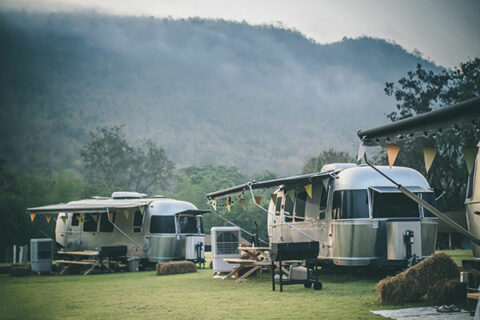
Airstream is one the most iconic brands of RVs ever made. It’s known for its distinctive, aerodynamic design. The company was founded in the 1930s by Wally Byam, and Airstreams are still made today by the Airstream Corporation, which is based in Ohio, United States.
An Airstream typically features an aluminum body, which gives it a shiny, silver appearance and makes it lightweight and durable. They come in different sizes and styles, from small, compact models that can be towed by a car or SUV, to larger, luxury models that require a heavy-duty truck to tow.
Airstreams are known for their high-quality construction, attention to detail, and luxury amenities. They have a distinctive design and a retro aesthetic that sets them apart from other RVs. They are considered a status symbol and are often seen as a luxury item, which makes them a popular choice among RVers who want a high-end, stylish RV.
Airstreams are popular among RVers who want to travel in style and comfort. They offer a high degree of mobility and flexibility, as they can be easily towed to different locations, set up at a campsite, and then hitched up and taken to the next location when the trip is over. They also tend to retain their value well and are often considered a good investment.
General Specifications
Size: 16 to 33 feet
Weight: 3,000 to 10,000 lbs
Price: $35,000 to $180,000+
Pros
High-end quality: The Airstream brand has stood the test of time largely because of their high level of quality and durability. Airstreams are known for their attention to detail and use of top-of-the-line materials.
Unique style: The shiny aluminum shell is unmistakable and the interiors match the unique and stylish design with curved walls and high-end finishes.
Longevity: Because of the high quality construction, it’s not uncommon to find Airstreams several decades old that still look great.
Resale value: High quality construction combined with the iconic look means most Airstreams maintain a high resale value for a lot longer than most types of RVs.
Comfort: Airstreams offer a high level of comfort and amenities, with many models featuring modern appliances, comfortable furnishings, and high-end finishes.
Cons
High cost: Even used Airstreams can be more expensive than other types of RVs, as they are known for their quality and luxury.
Compact size: Airstreams may not offer as much living space as larger RVs, such as motorhomes or trailers with slide-outs, which can be restrictive for some people.
Noise: Some people may find that Airstreams can be more noisy than other RVs due to the aerodynamic metal design.
Style: While considered iconic by many people, other people may find the “silver bullet” look dated or not up to modern standards. When reselling your Airstream, you may find your potential customer base is narrowed down to fans who like Airstreams.
Micro Camper

A micro camper is a small and compact recreational vehicle that is designed to be lightweight, fuel-efficient, and easy to maneuver. They are smaller than traditional RVs and offer a more minimalistic, bare-bones camping experience. They are also known as mini camper or tiny camper.
Micro campers come in different types and styles, from cute teardrop shapes to tiny rugged trailers and even tents on wheels. They can be either self-contained with basic amenities like a bed, kitchen, and bathroom, or they can be more simple, with just a bed and a portable toilet.
Micro campers are popular among people who want to travel and camp in a small and fuel-efficient vehicle. They are also good for those who are looking for a more minimalist lifestyle or for those who want to explore remote and rugged locations. They also can be a budget-friendly option for RVing, as they tend to be less expensive than larger RVs.
However, micro campers do have some limitations and are generally not suitable for long-term living or for larger groups or families. It is also important to make sure that the weight of the camper does not exceed the capacity of the vehicle that is being used to tow it.
General Specifications
Size: 8 to 12 feet
Weight: 500 to 30,000 lbs
Price: $5,000 to $20,000+
Pros
Lightweight: The small size and lightweight design allows for easy maneuverability and better fuel efficiency. It also means you can often tow most micro campers with just about any vehicle from trucks to SUVs or even minivans and some cars.
Easy parking: Most micro campers can fit in tight spaces or in areas where larger RVs are not allowed or won’t fit. For someone less comfortable with towing a larger trailer, a micro camper is a bit easier to maneuver.
Cost effective: As micro campers often come bare bones without any fancy amenities, they are the most cost effective RVs available.
Cons
Size: Space inside most micro campers is essentially just reserved for sleeping. Some sleeping spaces can be converted to seating areas, but any way you look at it, a micro camper is called “micro” for a reason and could leave you feeling a bit cramped.
Limited sleeping: Some micro campers can sleep up to 4 people (usually 2 adults and 2 children), but sleeping arrangements are cramped and generally reserved for just 1-2 people.
Food storage: Even small travel trailers or campervans usually have at least a couple cabinets or storage cubbies for food storage. Micro campers have less storage space for food and personal items and might require creativity when meal planning.
Weather: Small designs mean micro campers are more exposed to the elements and less insulated than larger RVs.
Horse Trailer
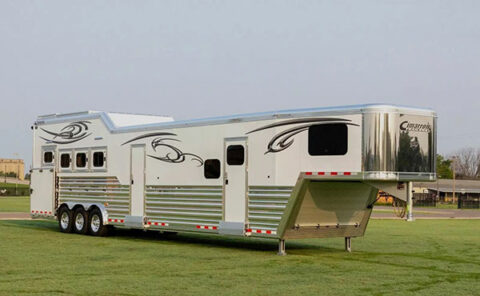
Yes, horse trailers can come with living quarters. These are often referred to as “horse trailers with living quarters.” They are designed to transport horses, alpacas or similar animals, but also have a living area for people.
The living quarters can include amenities such as a kitchen, bathroom, sleeping area, and living room.
Horse trailers with living quarters are typically larger than traditional horse trailers and can be quite luxurious, with features such as air conditioning, heating, and a full bathroom. They are also available in different sizes and styles, from small, basic models to large, luxury models. They can be equipped with all the necessary amenities to provide a comfortable place for the horse and human travelers.
These types of trailers are popular among animal enthusiasts who travel frequently to competitions, shows, and other events, as they provide a comfortable place to rest and care for their horses during long trips. They are also suitable for long-term living, as they can be used as a full-time residence for people who live on the road with their animals.
However, it is important to keep in mind that horse trailers with living quarters can be quite expensive, and that the weight of the trailer must be considered when choosing a vehicle to tow it. It’s also important to make sure the trailer meets safety and regulations, especially when it comes to the horse compartment.
General Specifications
Size: 20 to 40 feet
Weight: 4,000 to 16,000 lbs
Price: $20,000 to $100,000+
Pros
Cost effective: For owners looking to transport horses and stay with their animals, horse trailers with living quarters allow for time-consuming horse shows and trail rides without the need for a separate trailer or hotel accommodation.
Luxury amenities: It may seem like a strange juxtaposition to have animals in the back and living quarters in the front, but many models of horse trailers with living quarters have luxury amenities like bathrooms, kitchens and air conditioning.
Privacy: Sometimes it’s the little things that matter and a clean, comfortable space that keeps you out of the weather at a horse show and allows privacy to change your show clothes is the beauty of a horse trailer with living quarters.
Cons
Higher cost: If you’re choosing between a standard horse trailer or a horse trailer with living quarters, it should be obvious that the living quarters add to the initial price tag of the trailer. Of course, if you still plan to purchase and travel with a second trailer, then you have some more decisions to make.
Cleaning: With the proximity of animals staying next to your living quarters and just in general that you are likely camping in areas with a high concentration of horses or other animals nearby, it can take more effort to keep your living quarters in good condition.
Heavy: The extra living quarters add to the overall size of the trailer which requires higher fuel consumption and a bigger, stronger vehicle to tow the trailer.
Cargo Trailer

Converted cargo trailers are similar to a traditional RV, but instead of being built from the ground up, they are converted from an existing cargo trailer.
Cargo trailers can be outfitted with all the necessary amenities to provide a comfortable living space, such as a kitchen, bathroom, sleeping area, and living room. They can be customized to meet the specific needs and preferences of the owner.
The conversion process involves installing electrical and plumbing systems, insulation, and finishing materials, such as flooring, walls, and ceiling.
Cargo trailers are a popular alternative to traditional RVs among people who want to live in a small and mobile home perhaps with an alternative purpose to just camping. Many trailers are customized as mobile offices or mobile workspaces, and we’ve even seen mobile veterinary and mobile hair salons in renovated cargo trailers. These trailers offer a high degree of flexibility and mobility, as they can be easily towed to different locations, set up at a campsite or parking lot, and then hitched up and taken to the next location when the trip is over.
However, converting a cargo trailer into a tiny home or mobile office can be a significant undertaking, requiring time, money and some level of DIY skills and knowledge of electrical, plumbing, and carpentry.
General Specifications
Size: 8 to 32 feet
Weight: 400 to 6,000 lbs
Price: $1,500 to $9,000+
Pros
Low cost: You can find cargo trailers available at just about any trailer lot in your town. And since there aren’t a lot of features or “add-ons” available to a basic cargo trailer, you won’t break the bank when purchasing a cargo trailer to convert into a livable space.
Customizable: Because a cargo trailer is nothing more than 4 walls on a set of wheels, you have a clean slate to work with. Design every square inch to be just what you want.
Unique: There aren’t many companies that mass produce or renovate cargo trailers, so if you go this route, you will end up with a unique renovation and aesthetic that is one-of-a-kind.
Off-road: Some cargo trailers are designed with higher clearance to haul toys like ATVs, UTVs or motorbikes, making it more suitable to boondock and travel off-road where other RVs are not capable.
Compact: Most cargo trailers used for renovations are small and compact, making them easier to maneuver. And when it’s time to store long-term, they don’t take as much space in a driveway or garage.
Cons
Tight quarters: Cargo trailers are often just as wide as any other RV trailer but once you customize and add insulation, plumbing, walls and other interior modifications, you’re left with a space that can feel cramped and uncomfortable for long-term travel or living.
No windows: Unless you decide to cut holes in the walls to add windows, most cargo trailers do not come with pre-installed windows. Adding a window could change the structural integrity of the wall so it’s important to have the skill and knowledge to perform this type of construction.
Uncomfortable: A converted cargo trailer might look quirky and unique but it’s still a basic shell with modifications inside so it may not be as durable or comfortable as a factory-built RV or trailer.
Not the original purpose: Much like a school bus that is converted into a mobile home on wheels, cargo trailers were not intended for use as an RV. It’s important to ensure that the converted trailer meets safety and building codes, especially when it comes to electrical and plumbing systems. And the axles, frame and towing vehicle should be capable of handling the weight added in the conversion process.
Park Model
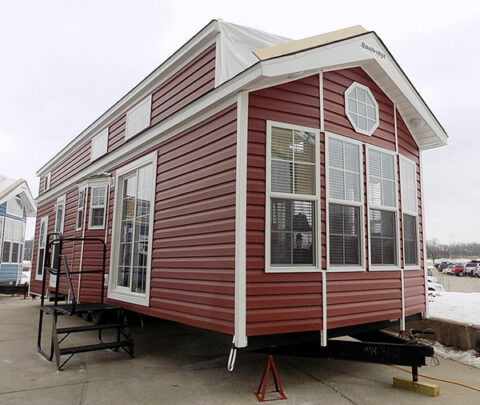
A park model home is a type of RV that is designed for long-term or permanent living. They are typically smaller and more compact than other types of RVs, such as travel trailers or motorhomes, and are meant to be placed in a designated RV park or campground and connected to utilities. They are also sometimes called “park trailers” or “destination trailers.”
Park model RVs are typically between 400 and 500 square feet in size and are built to a higher standard than traditional RVs, meaning they are meant to be lived in for a longer period of time.
They are outfitted with all the necessary amenities to provide a comfortable living space year-round, such as a kitchen, bathroom, sleeping area, and living room. They are also equipped with appliances, fixtures, and finishes that are similar to those found in a traditional home.
General Specifications
Size: 30 to 40 feet
Weight: 10,000 to 20,000 lbs
Price: $30,000 to $200,000+
Pros
Vacation home: Park model RVs are a popular option among retirees or people who want to have a vacation home or a second home that can be moved to different locations.
Affordable: Park model homes offer an affordable alternative to a traditional home while still offering many of the comforts you would find in a home
Mobile: While not designed to be moved as often as a motorhome or other RV trailer, park model RVs are built on a trailer frame with wheels and can be moved to another location.
Energy efficient: Constructed at a higher standard than most RVs yet smaller than a larger home, park model RVs are energy efficient and easier to maintain than a mobile RV or a larger home.
Cons
Semi-permanent location: Even though park model RVs are technically a recreation vehicle on wheels, they are not meant to be moved frequently. And when they are moved, they are meant to be transported via a professional hauling service.
Size restrictions: Some state or park restrictions limit the size of a park model home allowed in the space.
Location restrictions: While park model RVs can be placed on leased land in a variety of locations, such as RV parks, campgrounds, and vacation communities, they are not designed to boondock or park in spots that many other RVs are found.
Age restrictions: Many parks or vacation communities have restrictions on the age and design of the units allowed.
The RV Class Checklist
Shopping for an RV can be an exciting, but also a daunting task, especially if you are a first-time RVer. Whether you’re shopping for a new RV or simply deciding on what you want to rent for your next vacation, there are a few key factors to narrow down…
- Weekends or full-time? If you’re getting an RV to use on weekend camping trips, your needs will look different than if you’re planning extended travel or full-time living. Storage space, appliances, power for all those appliances, and things like work desk space become stronger consideration for longer trips.
- Count beds. Many RVs have the ability to fold down extra bunk beds or stow away dinettes that can sleep kids or even adults, but do you want everyone to have a fixed bed? Do you want to be transforming a dinette into a bed every night?
- Set a budget. RV demand has skyrocketed the past couple years leading to higher average prices for most new RVs. So it may make sense to browse the used RV market. Many renovated RVs in our marketplace are older RVs that have been given new life with improvements and renovations. Those renovations come at a cost, but the final sales price is often less expensive than new RVs from a dealer, and they have an aesthetic that might look more appealing than the boring, cookie-cutter design from the manufacturer. Keep in mind that you will also need to budget for things like insurance, maintenance, and storage.
- Do you have a tow vehicle (typically a truck or SUV) that you want to use? What are the towing, payload and hitch capacities of that vehicle? Or would you prefer to get a motorhome that tows a car behind?
- Check out different dealerships and private sellers. Look at RVs at different dealerships and private sellers to get a sense of the prices, features, and overall quality of the RVs that are available.
- Take test drives and inspect the RV. When you find an RV that you are interested in, take it for a test drive and inspect it carefully. Check for any signs of wear and tear, and ask the seller about the RV’s maintenance history.
- Consider financing options. RVs can be expensive, so consider financing options such as loans or leases. Be sure to shop around for the best interest rates and terms.
- Get insurance. RVs require special insurance, so be sure to get insurance for your RV before you take it on the road.
- Be prepared to be flexible. The perfect RV may not be available exactly when you’re ready to buy, so be prepared to be flexible and continue to shop around if you don’t find the right one.
- Rent before you buy. The RV rental market has a lot of options available around the country. Plan a long weekend vacation in a floorplan similar to the option you’re considering buying. You may learn things you hadn’t considered after spending a couple nights in that floorplan. You can find RV rentals on our rental marketplace or popular rental marketplaces like RVezy, RVShare or Outdoorsy.
While there are dozens of large brands of RV manufacturers to shop from in the US, most of those brands are owned by just a few parent companies, and most of the floorplans across those brands are pretty similar. After all, how much can you really change inside a frame no wider than 8 feet and generally less than 40 feet long?
After you take some time researching and completing this checklist, you can usually narrow your options pretty quickly.
So what do you think? Which RV class works best for you? Tell us in the comments below.




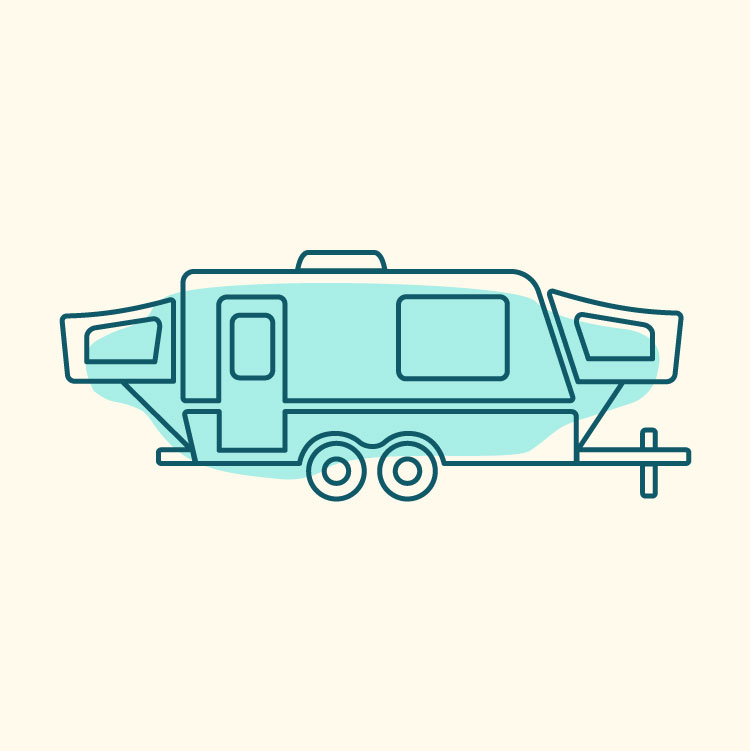

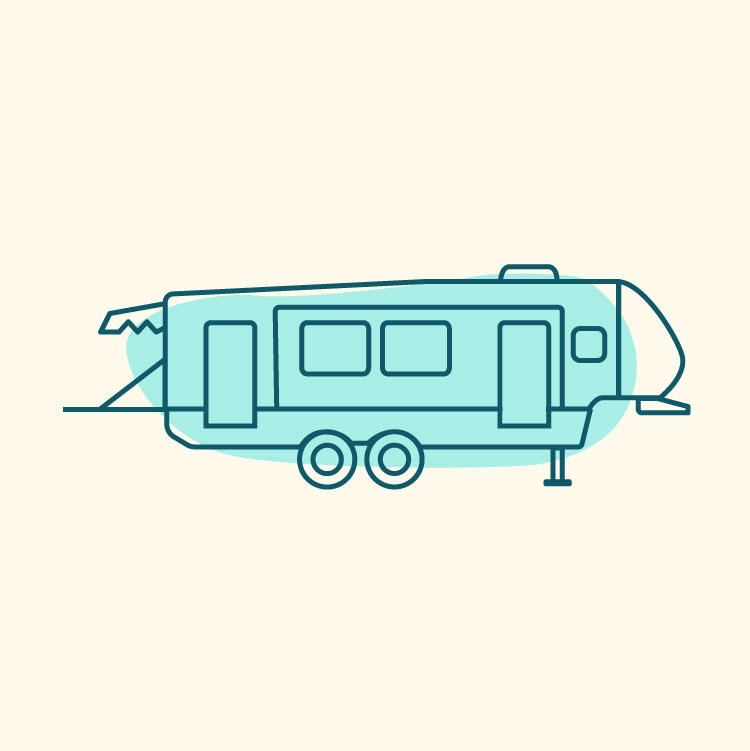




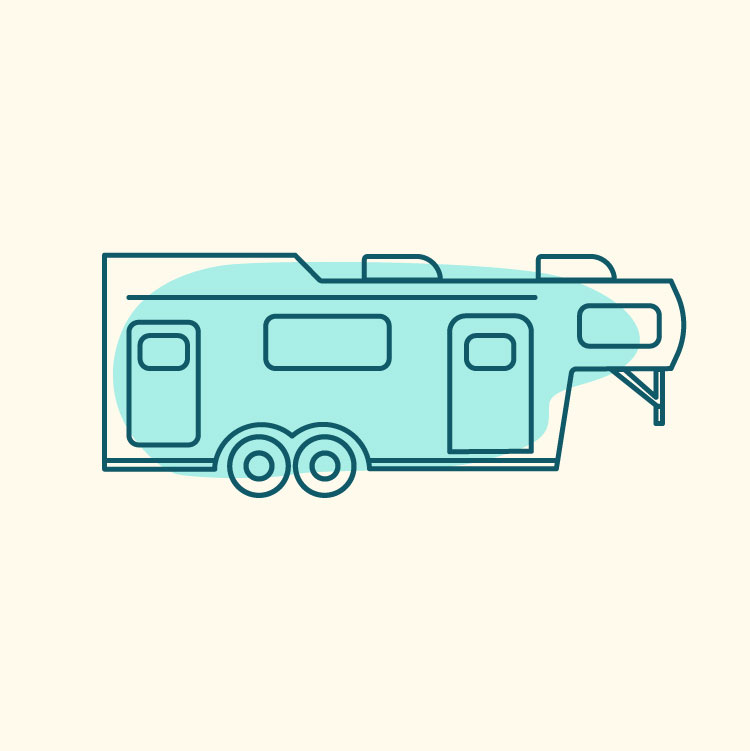

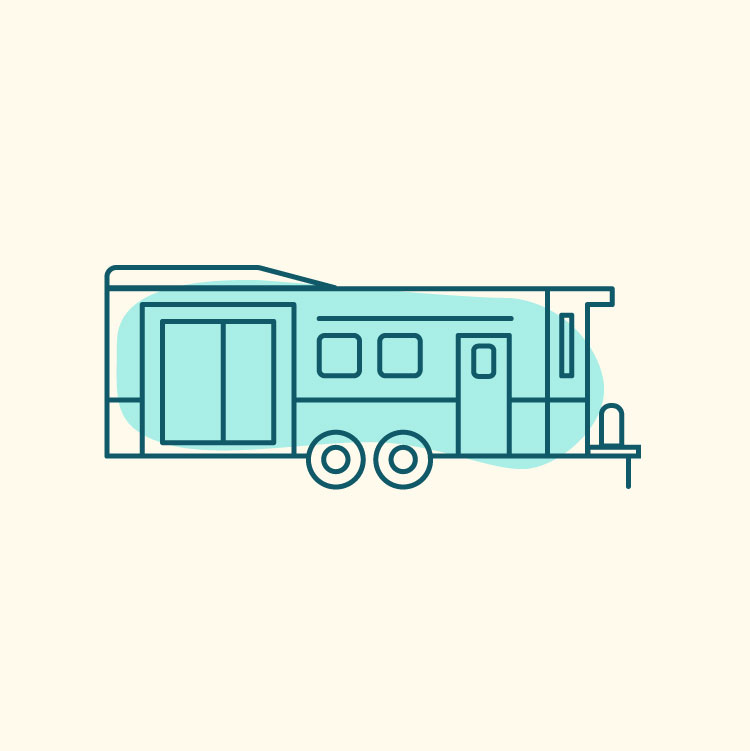
Comments